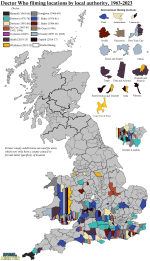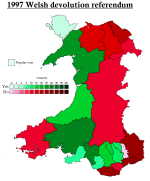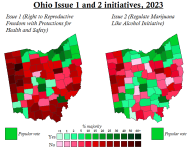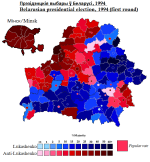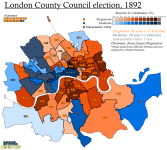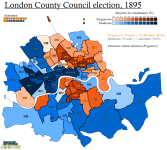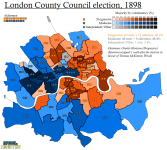I've been thinking for a while I'd like to do another British electoral map since it's been such a long time, and I finally found something I can do that hasn't been done to death thanks to this
yummy, yummy database of all the LCC elections.
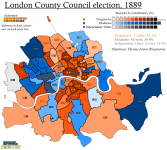
The London County Council, founded in conjunction with the formation of the County of London, kickstarted 96 years of continuous devolved government in the capital, and is arguably the first proper forerunner to the modern day GLA. The other candidate for that- its predecessor, the Metropolitan Board of Works- was replaced by the LCC because of a series of scandals in its running, its indirectly elected leadership, and the fact its juristiction was unclear given how much of the Metropolis could be claimed by the counties around it, especially Middlesex.
To solve this problem, the incumbent Conservative government (under pressure from the Liberal Unionists, who despite their famous hardline opposition to Home Rule for Ireland were fairly friendly to the desire for local government reforms on the mainland) made one of the provisions of the Local Government Act 1888 the creation of a formal County of London, which included almost the entirety of the old MBW area plus Wandsworth, Battersea and Dulwich from Surrey, and Lewisham and Woolwich from Kent, more or less creating what today is known as 'inner London'.
This area was also coterminous with the parliamentary boroughs used to make the parliamentary constituencies covering the same area, which were drawn as part of the Redistribution of Seats Act 1889 (and, as you can tell, had some hideous detached parts, because 19th century boundaries). Those constituencies were, in turn, chosen as the level at which the members would be elected. Each constituency elected twice as many councillors as it did MPs, so 2 for every regular seat and 4 for the City of London, by FPTP bloc vote. 19 Aldermen were also assigned to serve as members of the council, which was standard practice for the county councils created by the 1888 Act.
It had been hoped that the elections would be nonpartisan, but like the Tory hopes not to have to make a directly elected county council, this was not to be thanks to political pressure. Partisanship was a little different from normal elections, however, both in the sense that it was looser and in the sense that it didn't neatly align with traditional partisanship- that was especially apparent at this election since the parties didn't formally coalesce until after the election. I felt it'd be appropriate to use slightly different colours to normal to represent the competing parties to reflect this (and because it looks more interesting imo).
On the one hand, there was a Liberal-aligned grouping supporting the London Municipal Reform League, which a mixture of Liberals and Fabian-aligned socialists which had fought to introduce local democracy to the city since 1881. They remained united by an interventionist stance in a Lib-Lab esque arrangement, and after the election formed the formalised
Progressive Party, which ran the council until 1907 and remained the local banner for the Liberals until 1926.
The opposition basically comprised people who opposed the League, basically recreating the divide of the London School Board (which the LCC would take the powers from in 1904). The anti-League members didn't form a proper political party but did form a collaborative group of sorts with their own whip and their own name- the
Moderates (cue a visceral reaction from every Swede on the forum). This name for the right of the LCC would not be as long-lasting as the Progressive moniker, as by 1901 they formally became the local branch of the Tories.
There was also a weird third force in the sense of members elected who the figures in the table I link to don't identify as belonging to either faction, who I've marked down as independents. The plethora of unaligned candidates led to some very weird results, most obviously Hammersmith where an independent Moderate topped the poll in a three-way race separated by 1% of the vote (52 votes between first and third). Some independents were endorsed by their local Tory organisations without being claimed for the Moderates, too.
None of this really affected the bottom line of the election result, though. On a turnout just shy of half the electorate, the Progressive-aligned candidates won a comfortable victory, which was further extended by almost all the aldermen siding with them over (or in a few cases with them as well as) the Moderates. As mentioned, the Progressives would defend this majority in every local election until 1907, helped by the Liberals spending all but three of the next 17 years in opposition.
One interesting titbit is that the LCC in this term saw some landmarks for women's representation; since it wasn't clear whether they were eligible to serve, two women who were part of the Women's Liberal Foundation, Baroness Sandhust and Jane Cobden, ran as candidates under the Progressive banner and were elected (Sandhurst for Brixton, Cobden for Bow and Bromley). Sandhurst's election was successfully appealed by her Moderate opponent and she was forced out in May 1889, but Cobden managed to avoid being drummed out in part because she didn't participate for a year (though she got immediately challenged once she did). The Progressives also appointed Emma Cons as an alderman, the first woman to serve as one in London (and presumably the whole country, though I could be wrong).
I'm tempted to do more of these, but since power only changed hands three times and there were only a handful of really close elections, I don't think I'll do all of them. Fortunately the fairly comprehensive figures I found, and the fact the boundaries were always coterminous with London's Westminster constituencies, will make them quite easy to do if people are interested.


